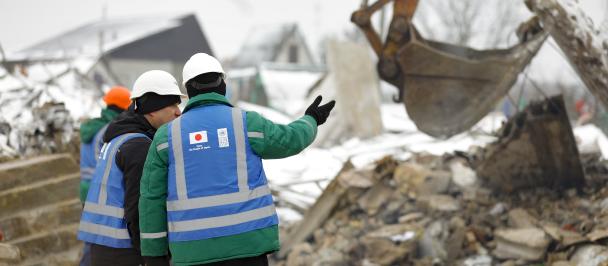A new countrywide energy assessment confirms damages exceeding $10 billion, with Ukraine’s capacity to produce electricity reduced by 61 percent. But with no let-up on attacks on energy networks, where does Ukraine go from here?
Uncovering the reality of Ukraine’s decimated energy infrastructure
April 12, 2023
The average Ukrainian household had to endure five cumulative weeks without power during the winter of 2022, according to recent estimates. That is 35 days in the dark, sometimes in below freezing temperatures. The dawn of 2023 has brought little to no respite, with the long winter months seeing temperatures continue to plummet.
What makes this particularly horrific, this crisis within a crisis, is that power cuts are about more than just not being able to turn on the lights. Energy affects every aspect of daily life and when it fails, communities suffer deeply. It disrupts healthcare, people’s work, children’s education. And perhaps most devastatingly during times of war, it also severs connections.
The recently released energy damages assessment on Ukraine delivers - for the first time - a comprehensive picture of the catastrophic damage wrought through the constant onslaught of attacks on energy infrastructure. Carried out at by the United Nations Development Programme (UNDP) and the World Bank, it provides the government and the international community with crucial data to help pinpoint where damage has occurred, to what extent repairs are possible and, arguably most importantly, identifies the funding needed for recovery.
It is undoubtedly a grim picture and is testimony to the intense suffering Ukrainians have faced over the last year. The $10 billion in damages means 12 million people with no or limited access to energy, 22 out of 36 power generation plants damaged, destroyed or inaccessible, and a large part of the heating infrastructure in war-affected areas broken beyond repair.
We should not forget the human faces behind this data. The most vulnerable, at risk of freezing to death during the harsh winter months. The small businesses striving to stay afloat with no internet connection, no lifeline to the outside world. And the hospitals and health centres relying on emergency generators, anxiously wondering how long they will keep running, and what they will do when they finally give out.
The emergency distribution of cooking stoves and heating equipment that the UN family has been providing is as vital a form of aid as food or water. For the most vulnerable, it is the difference between life and death.
Yet one year on from the start of this brutal war, the Ukrainian people deserve more than just emergency measures. Which is why this assessment also provides a roadmap to recovery, detailing not only the scale of the damage and the extent of repairs needed, but also clear proposals for ensuring that even during times of war, Ukraine’s energy infrastructure can continue to function.
Undoubtedly, it will take years to fully recover and will require international cooperation and investments on an unprecedented scale. Thankfully, the international community has been unwavering in its commitment to support Ukraine in its time of need. Over the last twelve months donors have responded swiftly, and with overwhelming generosity, ensuring funds quickly reach those on the ground. Led by the Ukraine government, energy repairs have swung into action, gas turbines are spinning, the lights are coming back on. Most importantly, emergency energy support is helping to protect lives and livelihoods, even in the most difficult of circumstances.
But more is needed. The assessment shows that there are three key pillars to Ukraine’s energy recovery. First and foremost, the most vulnerable need to have constant access to heating, water, and sewage services during periods of limited power supply or blackouts. Emergency repair costs, focusing on damaged and destroyed central heating power plants in Ukrainian cities, are estimated to reach $1.2 billion.
The second pillar relates to preparations for the 2023/24 winter season, which need to begin immediately to ensure there is no repeat of the situation so many families found themselves in this winter. The assessment estimates these costs at approximately US$1 billion, with funds urgently needed by June 2023 to ensure we can mobilize the technical equipment needed before the winter is upon us, once again.
Thirdly, Ukraine needs a path towards longer-term, sustainable and green energy sector recovery. Wind and solar power generation will be vital but the assessment shows that volume has decreased by more than half due to loss of control and damage. Now the groundwork must be laid for more decentralized power generation based on sources including biomass, biogas and waste-to-energy.
Photos: Pavlo Petrov / UNDP Ukraine
Because the ultimate aim must be an energy network that can withstand the crises of today, while also not contributing to the crises of tomorrow. The legacy of the energy attacks on Ukraine can be the catalyst for a renewed energy infrastructure that is less reliant on gas, that focuses on renewables and new and innovative green power solutions, and that ensures Ukrainian communities remain connected, in homes that are warm, near hospitals that are functioning, where children can attend school.
The energy damages assessment means we now know the scale of the task we face. We now know where we need to focus our resources and how much it will cost. We now need to come together and make it happen.

 Locations
Locations





